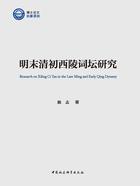
Abstract
Hangzhou,formerly known as Xiling,is a city of great importance in the history of Chinese ci poetry.During the transitory century from Ming to Qing,there appeared more than 400 ci poets,nearly 40 criticism of ci,and more than 10000 ci poems.According to Wu Xionghe,this indicates “a full-scale revival of ci poetry in Xiling in the early Qing dynasty”.The Xiling ci poets were pioneers in making a comprehensive study on the styles and history of ci,making contribution in several aspects,such as the anthologies,theories,tunes,rhymes,and scores of ci poetry.However,in literary studies of ci nowadays,the Xiling ci poets were neglected for a long time,and their characteristics and position in the history of ci poetry have been ambiguous.It has never been decided among academics whether the community of Xiling ci poets were a loose group or a well-organized school;its value and significance in literary history also remain to be explored.
In light of this,this study systematically examines,for the first time,Xiling ci poets' nature of being a community,in terms of both the activities of the poets and their theories.It systematically assesses the characteristics,evolution process,contributions,and limitations of Xiling ci poets,making analyses regarding their attributes both as and as not a school,taking into consideration their theoretical propositions and artistic pursuits.
The four chapters of this study respectively focus on the Xiling ci poets' general outlook,core artistic ideas and aesthetic advocations as seen in anthologies,the development of main ideas in ci criticism,and the changing characteristics in ci writing.This study holds that the Xiling ci poets constitute a community with the nature of a quasi-school,whose basic feature was an emphasis on aesthetical pluralism.This quasi-school was centered in Renhe and Qiantang areas,spreading to some part of Yuhang and Haining district,consisting of more than 100 ci poets from the years of Tianqi to Kangxi.This community advocates the combination of “graceful and restrained” and “powerful and unrestrained” styles,while doesn't have certain models as agreed masters.
Its development consists of two phases,which is divided by the publication of Xiling Anthology of Ci Poems and Jian Shan Ting Anthology of Old and New Ci Poems in the fourteenth year of Kangxi.The first phase is distinguished by an aesthetical pluralism based on sentiment-centered ideas,which later was regulated by a poetic moralism during second phase.Transiting from Ming to Qing,the second phase purified the sentiments of the first and elevated its style.
The Xiling ci poets were pioneers in changing late Ming's rigid atmosphere in which the dominating style were the sentimental and graceful.Their concerns for social reality and initiative in theoretical thinking contributed to the stylistic transition from one period to another,leading to a new outlook in ci poetry,one characterized by openness and inclusiveness,as can be seen in the flourishing of several schools of ci in early Qing.During the tenth to eighteenth year of Kangxi,in order to cope with the new practical and theoretical situation,the Xiling ci poets incorporated the sentiment-centered criticism into the Confucian moralism with some modification.This development indicates the upcoming of a new aesthetic trend,the “cultured and decent” of the Zhexi school.Generally speaking,the whole process of “the Revival of Ci” during late Ming and early Qing includes two periods,as marked by different aesthetical orientations:one of pluralism and one of “cultured and decent”.As a formidable force in the historical of ci poetry,the Xiling ci poets were initiators in the first,and followers in the second.
Key Words:Xiling Ci Tan;The Revival of Ci;Sentiment-centered;Graceful and Restrained;Powerful and Unrestrained